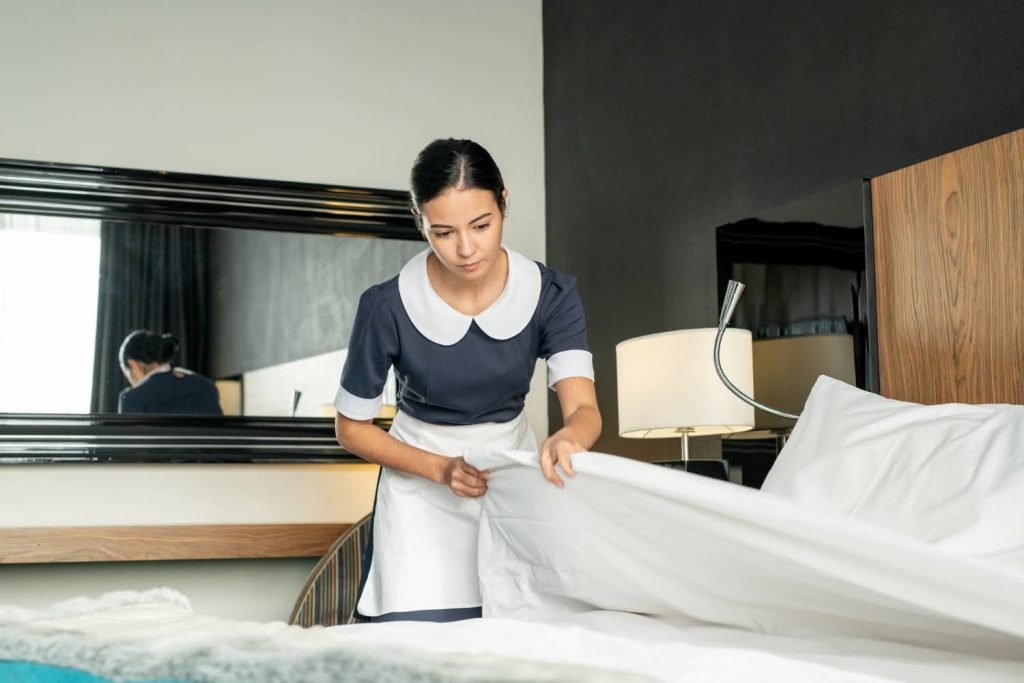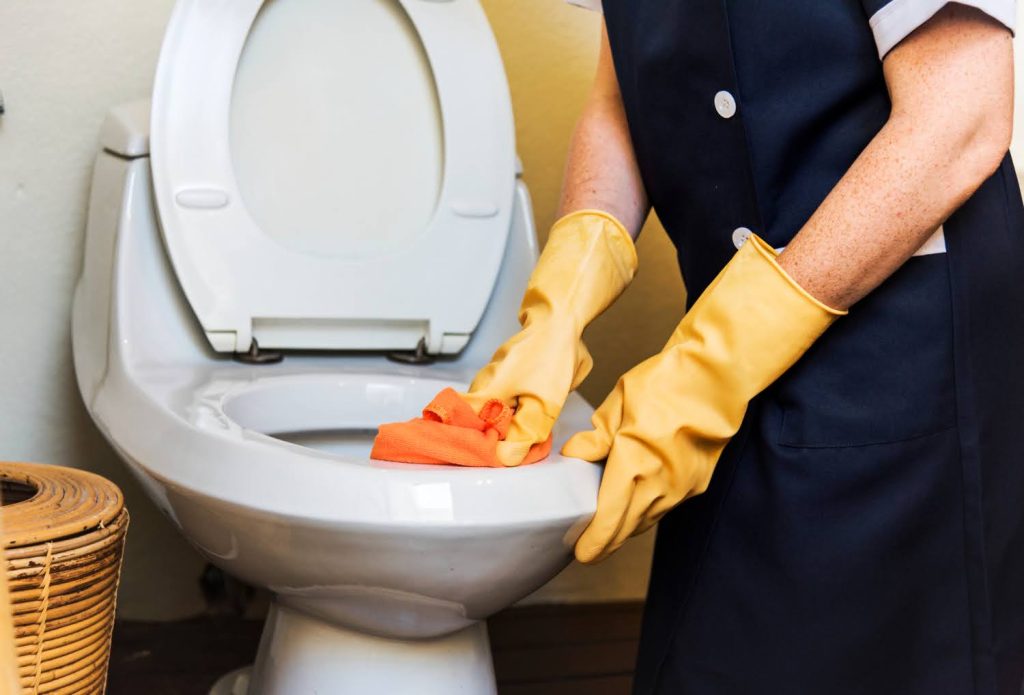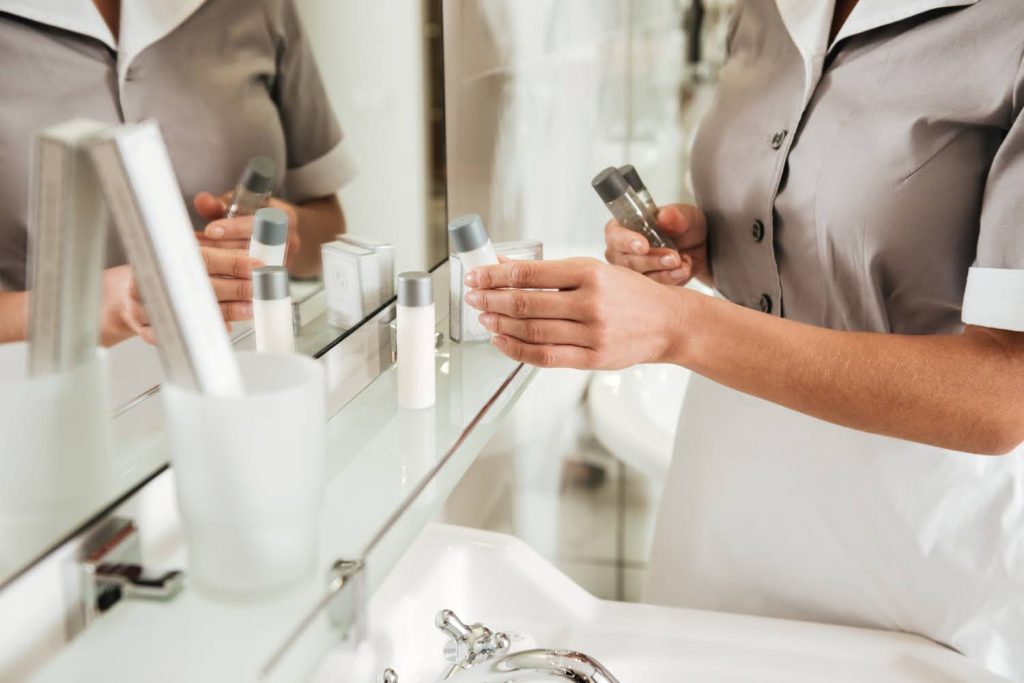Understanding how to clean a hotel room is vital to ensuring guest satisfaction and maintaining a high standard of hygiene and comfort.
A clean and well-prepared hotel room significantly impacts the guests’ experience, often dictating their overall impression of the establishment.
With this in mind, we have compiled an extensive guide detailing effective and efficient cleaning methods to help you create a welcoming and clean environment for your hotel guests.

Equipment, Supplies And Cleaning Products Checklist
The right equipment, supplies, and cleaning products are crucial to deep, thorough cleaning in hotel housekeeping. Each tool and product has a specific role, ensuring that every corner of the hotel room meets the highest standards of cleanliness and hygiene.
Let’s explore some of these essential items:
Vacuum Cleaner: A vacuum cleaner removes dust, dirt, and debris from carpets and floors. It effectively extracts dirt from deep within carpet fibres and is versatile for various floor types. Regular use of a vacuum cleaner enhances the room’s appearance and improves indoor air quality.
Mop And Bucket: Essential for cleaning hard floor surfaces, a mop and bucket effectively remove spills, stains, and grime. The mop absorbs and traps dirt, while the bucket allows for convenient wringing and rinsing. This duo ensures floors are visually clean and hygienically safe.
Floor Cleaner: Different flooring types require specific cleaners. For instance, pH-neutral cleaners are ideal for hardwood and laminate, while tile floors benefit from mild abrasives.
Carpeted areas need carpet shampoos, and stone floors require gentle, non-acidic cleaners. Choosing the right floor cleaner ensures effective cleaning without damaging the surface.
Surface Cleaners, Sanitisers And Bleach: These are essential for maintaining cleanliness and health safety in various environments. They are specially formulated to kill bacteria, viruses, and other pathogens commonly found on high-touch surfaces like door handles, countertops, and light switches.
Furniture Polish: This is widely used in hotel rooms to keep wooden furniture looking pristine and inviting. Regular application enhances the appearance of desks, chairs, and other wooden fixtures and provides a protective layer against wear and tear.

Bathroom Cleaner And Toilet Cleaner: A specialised bathroom cleaner is vital for addressing the unique cleaning needs of hotel bathrooms. It effectively removes soap scum, water stains, and other bathroom-specific grime, ensuring that the bathroom is not only visually clean but also hygienic.
Using a cleaner reserved only for the toilet is essential to ensure the toilet bowl is stain-free and disinfected, as well as limiting contact and any possibility of spreading germs. These items are crucial for guest health and satisfaction, as bathrooms are a focal point of cleanliness in a hotel room.
Rubber Protective Gloves: For hotel housekeeping staff, rubber protective gloves are essential. During cleaning, they protect hands from harsh chemicals and contaminants, ensuring staff safety. This is also important from a hygiene perspective, preventing cross-contamination between rooms.
Cleaning Cloths: They are used for wiping down surfaces to remove dust, grime, and spills. Made from materials like microfiber, cotton, or blends, these cloths can be used with water, detergents, or cleaning sprays for effective cleaning. They’re reusable, making them environmentally friendly and cost-effective.
Dusting Cloths And Dusting Tool: Dusting cloths are specifically designed to attract and hold dust particles from various surfaces, including furniture, fixtures, electronics, and more. They can be made from materials like microfiber, effectively trapping dust without chemical sprays.
Meanwhile, dusting tools are beneficial for cleaning hard-to-reach areas such as the tops of wardrobes, light fixtures, and window blinds.
Scrubbing Brush: In a hotel setting, a scrubbing brush is used for stubborn stains and build-up in areas like tile grout, bathroom floors, and outdoor balconies. Its use ensures that all surfaces are thoroughly cleaned, maintaining the hotel’s reputation for cleanliness and attention to detail.
Drain Cleaner: Regular use of drain cleaner in hotel rooms prevents clogs and unpleasant odours in sinks, showers, and bathtubs. This preventative maintenance is key in ensuring guest comfort and avoiding plumbing issues that could negatively impact a guest’s experience.
Air Freshener: This is used in hotel rooms to create a welcoming and pleasant atmosphere. They are especially useful in neutralising odours and refreshing the air between guest stays. The choice of fragrance can also contribute to the hotel’s signature ambience.
Bin Liners: Using bin liners in hotel room waste bins is a standard practice for maintaining hygiene. They make trash disposal more efficient and ensure the bins remain clean and odour-free.
Bathroom bin liners are also important for managing smaller waste items typically found in bathrooms, such as tissues and sanitary products. They aid in keeping the bathroom tidy and hygienic, a detail guests will notice and appreciate.

How To Clean A Hotel Room
Cleaning hotel rooms is a task that demands attention to detail, a commitment to hygiene, and an understanding of the unique needs of a hospitality environment. The goal is not just to clean but to create an inviting, comfortable, and safe space for guests.
This involves a thorough and systematic approach to ensure that every area of the room meets the high standards expected in the hospitality industry.
Once you have gathered all the necessary supplies and cleaning products, follow the steps outlined below to ensure a clean hotel room for your guests.
1. Ventilate The Hotel Room
The first step in cleaning a hotel room is to ventilate it properly. If possible, this can be done by opening windows to allow fresh air to circulate. In rooms without windows or where opening windows isn’t practical, adjusting the air conditioning can help circulate air and remove stale odours.
Adjusting the air conditioning in a hotel room involves setting it to a comfortable temperature and fan speed to enhance air circulation and ensure a fresh, welcoming atmosphere for guests.
This step is essential for removing lingering smells from previous guests and creating a welcoming atmosphere. For example, in a seaside hotel, opening windows can also let in the fresh, salty breeze, further enhancing the guest experience.
2. Prepare The Room
This step involves preparing the room for a thorough cleaning. This includes stripping the bed of all linens and pillowcases, which should be replaced with fresh ones for the next guest. Any clutter left behind by previous guests, such as magazines or used amenities, should be cleared away.
It’s also an excellent time to open the windows for air circulation, if not already done in the previous step. This helps refresh the room and prepares it for the more intensive cleaning tasks. For instance, this involves removing decorative items in a boutique hotel for individual cleaning.
3. Dispose Of Used Items
Remove all items that need to be replaced or cleaned. Gather and dispose of any rubbish left in the room’s bins, and remove used and dirty towels and beddings for laundering. This step is crucial for maintaining hygiene and preparing the room for the new guest.
It’s important to check all likely places for rubbish, including drawers and under the bed. In a luxury hotel, you might also replace single-use items like shampoos and soaps at this stage.
4. Tidying Up
The next step is to organise everything to streamline the cleaning process. This could include aligning chairs, straightening curtains, and placing the remote control back in its designated spot.
The goal is to bring the room back to its standard layout, making it easier to clean systematically and ensuring no areas are overlooked.
5. Apply Cleaning Agents In The Bathroom
Start the cleaning process by focusing on the bathroom, as it typically requires time for the cleaning agents to work effectively. Apply cleaning agents to critical areas such as the toilet bowl, shower walls, and sink.
Apply a toilet bowl cleaner inside the toilet for deep cleaning, while a separate agent can be used on shower walls to tackle soap scum and mildew. This step ensures the cleaning agents have sufficient time to sanitise and break down dirt and grime.
6. Dust and Vacuum
While the cleaning agents are working in the bathroom, begin dusting and vacuuming the main room. Pay special attention to high-touch areas such as light switches, door handles, remote controls, and telephone handsets, as these are frequent contact points for guests.
Vacuuming should cover all carpeted areas, and in cases of hardwood or tiled floors, a microfiber mop can be used for dusting and cleaning. This step is crucial for removing allergens and maintaining a dust-free environment.
7. Make The Beds
Freshly made beds are a centrepiece of any hotel room. Strip the beds of used linens and replace them with clean, crisp bed sheets, ensuring they are neatly tucked and presented.
The process might include adding a decorative throw or arranging pillows in a specific way, depending on the hotel’s standards. The goal is to create a clean, comfortable, and visually appealing bed, inviting guests to relax.
8. Surface Cleaning
Clean all surfaces in the room, including desks, nightstands, and window sills, using appropriate cloths and cleaning agents. This step involves dusting and sanitising surfaces to ensure they are hygienic.
For instance, extra care might be taken in a family suite to clean and sanitise surfaces children are likely to touch, like lower tables and TV stands.
9. Clean The Bathroom Thoroughly
Return to the bathroom to thoroughly clean all surfaces, including the toilet, shower or tub, sink, and mirrors. The cleaning agents applied earlier have had time to work, making it easier to scrub away grime and build-up.
Special attention should be given to faucets and showerheads to leave them shining. The aim is to leave the bathroom spotlessly clean and hygienic, which is often a primary concern for guests.

10. Restocking The Room
The final step is to restock the room with all the necessary items. This includes replenishing the minibar, replacing used dishes, and ensuring that amenities like coffee supplies, toiletries, and towels are fully stocked.
This might also involve adding complimentary items like chocolates or a handwritten welcome note for guests in a luxury hotel. Restocking ensures that every guest has a seamless and enjoyable experience with all their needs catered for.
11. Vacuum The Floors
The type of vacuum cleaner used should be appropriate for the floor type in the hotel room. A vacuum with a beater bar or brush is ideal for carpeted rooms to lift dirt from the fibres. Use a vacuum with a floor brush attachment for hardwood or tiled floors to avoid scratching the surface.
Ensure all areas, including under the bed, around furniture, and edges, are thoroughly vacuumed. This step is vital for removing any remaining dust, dirt, and potential allergens from the floor, contributing to the room’s overall cleanliness and air quality.
12. Check Details
This step involves a detailed inspection of the room. Check for any stains on carpets, upholstery, or curtains that might have been missed during cleaning. Ensure that all amenities the hotel provides, such as coffee makers, hair dryers, and televisions, are in good working order and condition.
This step is crucial to guarantee that everything in the room is functional and meets the hotel’s standards of quality and comfort.
13. Hotel Room Disinfection
In this step, focus on disinfecting high-touch points in the room, such as door handles, light switches, remote controls, telephone handsets, and any other surfaces frequently touched by guests.
This is an essential step in the current health-conscious environment to minimise the risk of germ transmission and ensure the room is safe for the next guest.
14. Visual Inspection
The housekeeping manager or a designated quality assurance team member should thoroughly inspect the room. This process involves meticulously checking the functionality of items like lamps and electronic devices, verifying that all light bulbs are operational, and scanning for any fresh stains or signs of damage that may have been missed earlier.
Confirming that the room meets the hotel’s cleanliness and presentation standards is also crucial. This step ensures that the room is clean, in perfect working order, and ready to provide an excellent experience for the next guest.
15. Final Room Check
Conduct one last comprehensive room check to ensure everything is in place and cleaned thoroughly. Adjust the air conditioning to a comfortable setting for the incoming guest, and if the hotel uses a signature scent or air fresheners, apply it now for a pleasant first impression.
This final step is crucial in ensuring that no detail has been missed and that the room is ready to provide a delightful experience for the next guest.
Conclusion About How To Clean Hotel Rooms
Cleaning a hotel room is a meticulous process that requires careful attention to detail, a systematic approach, and appropriate cleaning methods and products. Each step, from ventilating the room to the final inspection, is crucial in ensuring that the room is spotlessly clean, welcoming, and comfortable for guests.
If you require professional and efficient cleaning services, ESP Cleaning Services is an excellent choice. With our expertise in commercial cleaning, you can rest assured that your hotel rooms are maintained to the highest standards, providing guests with a memorable and pleasant stay. Request a non-obligatory quote to get started.
Frequently Asked Questions About How To Clean Hotel Rooms
How Long Does It Take To Clean A Hotel Room?
Cleaning a standard hotel room typically takes around 30 minutes. This timeframe encompasses tasks such as making the bed, dusting, vacuuming, cleaning the bathroom, and restocking amenities.
However, the time can vary based on the room’s size, the cleanliness level required, and the hotel’s policies. The cleaning process can extend to 45 minutes or even an hour for larger or more luxurious rooms and suites.
What Are The Benefits Of Hiring A Commercial Cleaner Instead Of Using In-House Cleaning Staff?
Hiring a commercial cleaner can bring several benefits, including access to specialised cleaning expertise and equipment, reduced overhead costs associated with hiring and training in-house staff, and the ability to scale cleaning services up or down based on occupancy and seasonal demands. Commercial cleaners also often bring professionalism and efficiency by focusing solely on cleaning services.
What Should I Look For When Hiring A Commercial Cleaner For My Hotel?
When hiring a commercial cleaner, look for a company with a strong reputation and experience in hotel cleaning. Check for proper licensing, insurance, and adherence to health and safety standards.
It’s also important to inquire about their staff training procedures, the cleaning products and equipment they use, and their flexibility in accommodating your hotel’s specific needs and schedules.
How Often Should Hotel Room Carpets Be Deep Cleaned?
Hotel room carpets should be deep cleaned regularly, depending on foot traffic and usage. Typically, deep cleaning is recommended every 3 to 6 months. However, a more frequent deep cleaning may be necessary in high-traffic areas or during peak seasons.
This process involves using a carpet cleaner machine that can remove deep-seated dirt and stains, ensuring the carpet is clean on the surface, hygienic, and free from allergens.
What Are The Best Practices For Laundering Hotel Linens And Towels?
Hotel linens and towels should be laundered using high-quality detergents and, if possible, in high-temperature washes to ensure thorough cleaning and disinfection. It’s important to sort linens and towels by colour and type to prevent cross-contamination and to maintain their quality.
Frequent inspections for stains, tears, or wear and tear are crucial, as damaged or worn linens should be replaced to maintain high standards.
How Should You Clean A Hotel Room That A Guest With Allergies Has Used?
If a previous guest has allergies, extra care should be taken to eliminate dust and allergens. Use hypoallergenic cleaning products, and ensure that all surfaces, especially high-touch areas, are thoroughly cleaned and disinfected.
Beddings and curtains should be laundered with hypoallergenic detergents, and if possible, use air purifiers to maintain clean air in the room. Avoid using scented products or air fresheners that might trigger allergic reactions.

